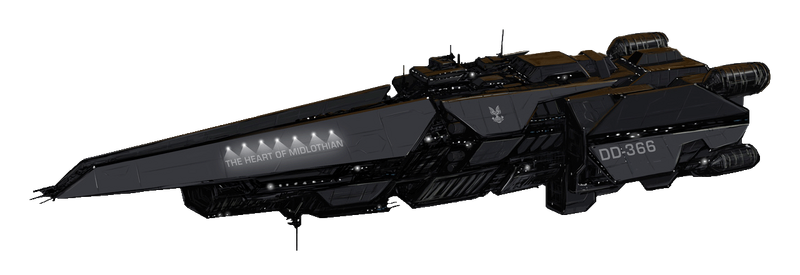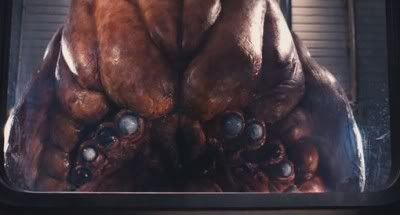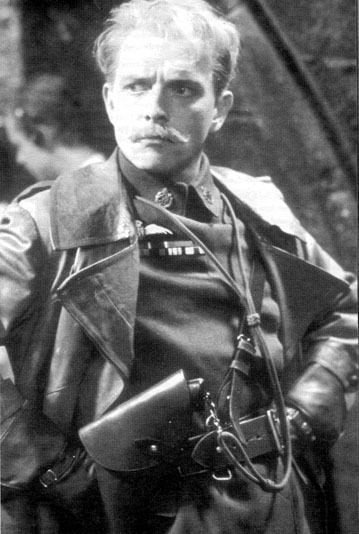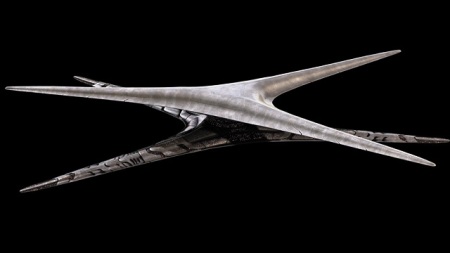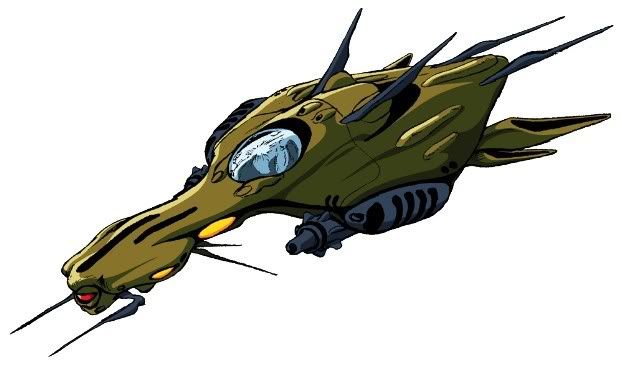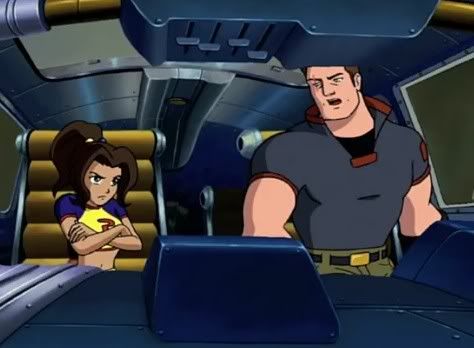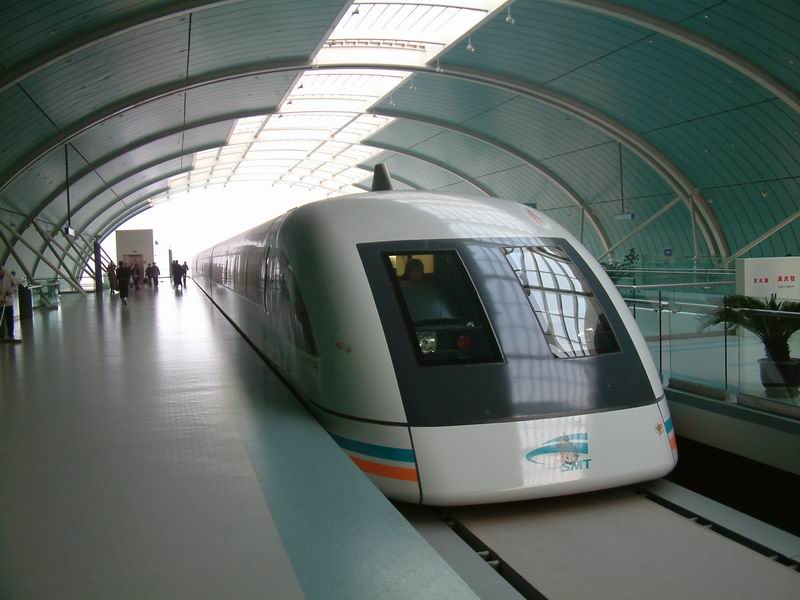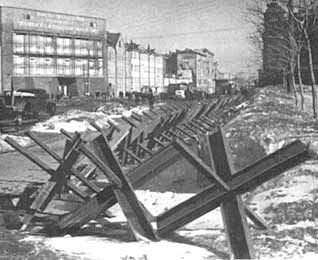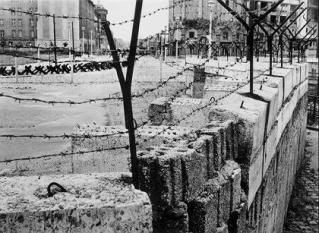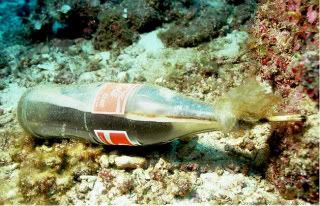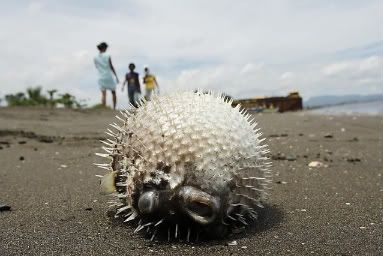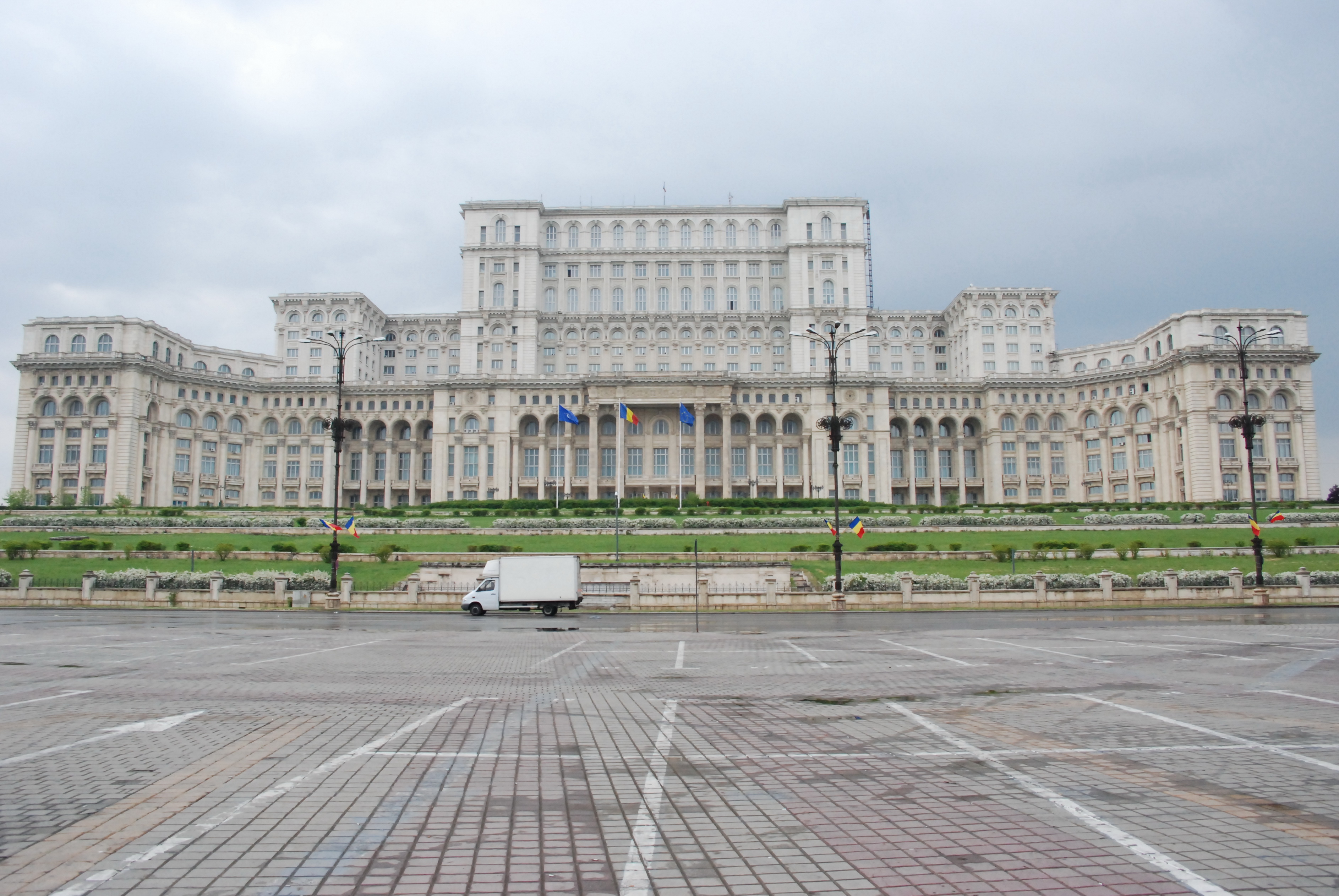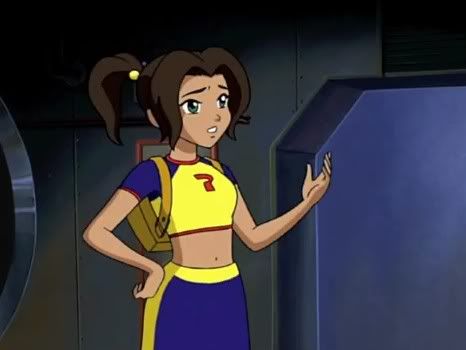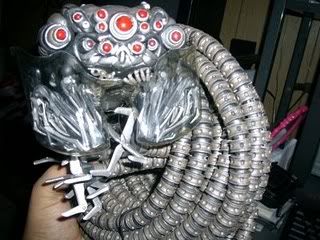Recommended Music:
Carl Neilsen's Symphony No. 4
Corsair-C class pursuit cutter CG-81634 “Greyhound”,
Hawk's Nest System
Approaching Target Group Two
0931 Hours, June 7, 3400
Cardwell's eyes narrowed. Something was happening; the stealth ships had stopped firing.
"Piranha Five-One, this is Piranha Leader. I need a sitrep on those stealth ships." Nothing, not even ELINT cutters, could beat the customs boats for fine resolution; the need for detailed scans of what a ship was doing was vital to their mission.
"Ah... looks like they're turning about."
Trying to run? Not smart; they'd given up too much of a velocity advantage by
not running earlier, and the gunships would be on top of them in minutes.
No. She knew the enemy ships had some kind of heavy axial gun... that meant broadside secondary armament on the flanks.
Nothing for it but to charge through the fire; if they launched from this far out the missiles would be ballistic.
The first flurry of plasma bolts was wild- gunners who had their settings wrong? Local fire control that hadn't locked properly? Impossible to say. The second and third started getting shot in, thouhg, too close for comfort. Beam halo crackled by her, and she heard a buzzing report: "This is Piranha One-Four, we've lost forward sensors; laser panel is offline."
"Hold formation. We'll cover you. One-Two, One-Three, take up position off One-Four's flanks and go to barrage jamming." With luck that would keep the enemy from pointing sensors this way when there were more easier targets. She herself slotted into a trailing position behind the other three and below them, then switched to intercom. "Tom, go to barrage jamming too." She was group leader, yes, but
damned if she'd forget her own flight in the shuffle.
The Centralists had another run of bad luck: three ships took it into their heads to concentrate fire on a few of their little pyramids. Even without a good lock, the sheer volume of fire being thrown at best-guess figures for the Fireballs' positions was enough to kill another two; the other three ships managed to wing another Centralist in the next five-ship over... then put a tight-focused bolt into one of Wildcat's melee boats.
They were getting
damned close now...
Command Bridge, CNS Loyalist
0932 Hours
They were getting
damned close now...
Commodore Liggs watched with bated breath as the pirate fighter force charged towards his own Hawks.
Then it happened- the enemy made their first mistake. A few of the fighters in the lead of the enemy swarm launched their missiles. Then a few more. Soon, scores, then hundreds of the pirate craft were dumping ordnance and braking... were they trying to match course with the Hawks?
Finally, the pirates had started acting like a proper rabble. And Liggs was not one to interrupt an enemy while he was making an exploitable mistake. Fortunately, there was nothing he needed to do except watch. His ships were fully ready, the enemy fighters had launched their strike from too far out; their failure was going to be a matter of arithmetic. His command might well take hits, but the devastating strike he'd worried about facing had just been aborted.
He would take a certain grim pleasure in watching what was going to happen next.
Pirate Vessel Keldrog's Gutting Blow
Keldrog watched in shock and fury as his carefully mustered fighter force, as one, did precisely the wrong thing. The rage was so intense he began bellowing curses at the distant fighters from his own bridge, hissing, his claws spread wide as if for the signature combat tactic his ship was named for.
"
Useless, stinking idiots! Pre-heated meat! Did your mothers shit in your eggs before you hatched?"
The Warlord slammed his clawed hand into a nearby stanchion, gripping it with crushing force. His orders had been simple and clear: a charge, a launch of missiles at the ideal range, then break away and use beam weapons to finish off cripples or enemy small craft. But watching his fighter wing, he saw what had gone wrong.
His fighters had been forced to stay hidden in the Trojan debris field for too long, with too few visits to the handful of retrofitted freighters he'd kept in the field as carriers for their crews to rest and recuperate. For pilots of his own species, that would have been acceptable: the race of Gron was tough and self-sufficient, bred by an unforgiving homeworld to go on in the face of physical discomfort for many days. But most of the fighter pilots under his command were not Gron- he had swelled his ranks with all manner of opportunistic aliens, including the ubiquitous humans.
With the commendable exception of a band of Airaii mercenaries, few of the aliens had the endurance and self-discipline of a Gron warrior. The long wait in ambush had taken its toll on them, both physically and mentally.
Thus, it was perhaps no surprise that their weak command structure had broken down along factional lines. Or that effectively independent squadrons had started dumping their ordnance and engage the oncoming Centrality fighters directly rather than take the casualties from plowing through their ranks and firing their missiles at optimum range against the human starships. And once the first squadrons started doing so, the prospects of the head-on attack became steadily worse: soon, even the Airaii and Gron pilots were forced to launch or be abandoned by the great mass of alien rabble.
Keldrog squeezed the stanchion still harder as his plot showed the first consequences unfolding. The Centrality fighters were badly outnumbered, but showed a level of discipline and organization he would cheerfully have killed for- starting with several of his own squadron leaders. As they saw the antiship missiles separate from the fighters that had been carrying them, they made the perfect choice: they fired on missiles in passing.
Light pulse lasers stitched out from the Centrality formation, according to fire plans carefully assigned by the central fire directors on the squadron leaders' craft. The missile barrage was a lumpy cloud, dense in some places and sparse in others; the Centralists chose to target the thinnest spots in the cloud, and often managed to completely shoot their way through in the short span of time available. Then they broke off, to port*, as if daring the Keldrog's fighters to pursue... which they did, killing velocity and looping back towards the Centralists' vector in pursuit as the two forces bled off their momentum and merged into a confused low-speed beam duel. It was a chaotic mess, but Keldrog could see how it served his enemy's purpose: the fighters themselves would not be charging in along with the missiles to fire their own beam weapons in support.
The fact that his own pilots outnumbered the Centralists nearly two to one did not seem to have entered into their calculations. But even if his own fighters won the turning battle handily, it would not change the fact that he had just suffered a major setback.
At least the human ships' electron beams had stopped shooting. He wondered why...
*[Author's note: if you note inconsistencies in Keldrog and the human commanders' view of the fighter maneuvers, consider the reason
why they might not label the same direction in the same way... cookie for anyone who figures it out.]
Central Information Control, USS Directrix
0933 Hours
Rear Admiral Hazarika had been no less surprised than Commodore Liggs to see the pirate fighters launch early and dive into a useless furball with the Centrality fighters. She, unlike the Centralist flag officer, had one more order to give.
"All ships, go to raster fire." The deckplates gave a low-frequency rumble as the four dual beam turrets echeloned across
Directrix's dorsal hull turned to bear to port- the bearings might be frictionless, but the stresses in the hull from the turret motors were enough to be noticed throughout the ship. The vibrations died.
The Centralist fighters had performed commendably against the enemy's antiship missiles;
Raider-model interceptor drones could have done no better. By concentrating on the thinner parts of the missile distribution, then ducking out of the line of fire, they left the incoming salvo trimmed back into tight clusters with no friendlies nearby... perfect for main battery antimissile defense.
The Centrality ships' mass drivers, with nothing better to do at this range, had already sent the first salvoes of flak shells on the way; as seconds ticked by, the Umerian gunners got their electron beams ready for raster fire. Her inner ear flickered under a brief, disorienting moment of centrifugal force as
Directrix's station-keeping thrusters found the right setting to cancel out the torque caused by the recoil from broadside fire. There was no way to feel it, though, as the muzzle dipoles began panning the beams across the target volumes.
Raster fire was a technique made possible only by the use of continuous beam weapons. Main battery control set their focusing magnets with indifference to beam cohesion and used the gun's fine adjustment steering magnets to pan it back and forth across space like an ancient cathode ray tube. A barrage of high-energy particles strong enough to drill starship shielding instead became an oncoming wall of radiation, each gun saturating areas dozens of kilometers across per second.
Against shielded warships- even unshielded ones with adequate armor- raster fire over such broad areas wouldn't even be an inconvenience. Against relatively fragile missiles, on the other hand, it was deadly. They weren't armored or shielded against radiation flux that made bathing in a solar storm for weeks look mild by comparison; certainly not when that kind of dose was delivered in a matter of seconds. Casings scorched and half-melted; hardened electronics battered beyond their capacity died.
Of course, sweeping an area a hundred kilometers across in a few seconds wasn't enough to stop all the missiles by any stretch of the imagination... but aimed at the thickest concentrations, it simplified the point defense problem tremendously. Scores of missiles were blotted out, faster than the eye could have followed; there were reasons why swarms of individual targets on Umerian CIC plots were shown as a cloud of iridescent fog according to density, instead of as discrete points.
Meanwhile, the Centrality ships, lacking their own equivalent of Umerian electron guns, took advantage of their as yet unused mass driver armament. The mass drivers were meant for overwhelming short-ranged fire, or long range bombardment of clumsy targets. Here, the gunners loaded time delay fuzed shells and fired in the general direction of where missiles were expected to be. The flak shells were riddled with potential fracture points; when the explosive charge lit off they burst into enormous clouds of hypervelocity fragments.
Colliding with a piece of shrapnel from a mass driver flak burst was a threat to shielded fighter craft; when a missile experienced the same, it vanished as if it had never been.
The missiles were coming through the beaten zone of the main armament now- there had been thousands of them, and even the storms of lightning and steel thrown out by the Coalition ships' heavy guns were not enough to more than punch out some of the tightest clusters. Now the job fell to lighter, quicker-firing point defense. The Centrality ships kept up their flak barrage, but smaller, lower-velocity guns that spread broader flak footprints chimed in, as did pulse-firing burst lasers. The Umerians simply lit up the phased array laser grids on the sides of their ships and never stopped firing, switching from one target to the next under computer control and alloting as many square meters of panel as it took to burn each missile down with a torrent of infrared light.
Supplementing the guns, both contingents threw thick barrages of countermissiles into the fray. The Centrality's preferred point defense missile was essentially a self-powered railgun shell, and worked along the same principles as their flak shells: saturation of the area in front of the target with so many fragments that even in space, there would not be room to slip between them. The velocity of collision did the rest.
The Umerians, by contrast, preferred to protect their starships with copies of the fighterweight Mark Five missile, with its shaped nuclear charge. They didn't need a direct hit or anything like one; they didn't even need an intercept in the classical sense of the word. As long as the missile could get within a few dozen kilometers of its target for a millisecond or so, the cone of tungsten plasma blasting out of the warhead would see the enemy missile off, burning and battering it if not vaporizing it outright.
Likewise, both contingents tried to cover their ships with jamming: the Centralists with blinding, overpowering bursts that sought to destroy sensors outright or hopelessly confuse them, the Umerians with dancing will-o-wisp light shows provided at lower power by the VLA drones supporting the ships' sensor grids.
All in all, it was almost enough to save the Coalition starships from harm.
Most of the missiles fired by the pirates had been taken down by point defense- with so long to calculate trajectories, the intercepts had been easy. Most of the missiles not killed were spoofed by ECM- with so long to experiment with what each missile could be fooled by, the ships' computers had managed to mislead almost everything they hadn't allotted the firepower to kill. It was a rare, lucky few that actually made it to the target.
Most of the pirate antiship ordnance didn't even bother with a warhead; designing a warhead more powerful than the raw impact of a missile at those speeds was a challenge beyond what their suppliers cared to meet. The first hits landed on the Centralist destroyer
Hector, pushed out toward the port side of the Coalition formation.
Hector managed to take several hits on the shields, four impacts splashing off harmlessly before the defensive screens flared violet and died; unfortunately, the destroyer had been the target of seven surviving missiles.
One dived into the brilliant radar reflection from the angle where
Hector's aft plasma turret joined the hull, slamming through the barbette and carving a brilliant trench through the hull plates on the far side. The detached turret drifted away slowly, its contents shattered.
The second was something of a disappointment from the pirates' perspective: it was a dual-role missile designed for solid kinetic impact or flak detonation, and its launching fighter pilot had mistakenly set it to "flak." The resulting hail of antitank impactors stripped surface features across much of
Hector's port flank, but at no point managed to penetrate the heavy, cofferdammed armor belt underneath.
The third, however, a larger torpedo-weight weapon from one of the Gron fighters, penetrated the main armor belt, as its comrade had failed to do a second earlier. It even punched through the secondary belt around the ship's core. The jet of volatilized wreckage and missile fragments speared the power distribution banks for
Hector's forward reactor and continued through the core hull until smashing up against the armor on the opposite side, splashing outward from the impact.
The reactor failed-safe as designed, but the mushrooming effect of the remains of the Gron missile ripped through
Hector's vitals like an exploding bullet, destroying critical systems along a hundred meters of the ship's length. The combined effect killed nearly fifteen percent of her crew- with nearly half the others suffering injuries ranging from crippling burn damage and severed limbs down through cracked ribs and concussions. Between the loss of her aft turret and the destroyed power trunks to her forward one, her main battery was effectively disarmed, save for a handful of mass drivers aft.
The other ships on that side of the formation suffered less severely. Another missile clipped the Centralist frigate
Terrier across the dorsal surface between gun turrets, destroying light weapons mounts and disabling the mass drivers mounted amidships, but causing only light casualties and damage- mostly by luck.
The Umerian frigate
Cairo took a similar hit across the ventral surface, shearing through the VLS missile racks that had been spitting countermissiles seconds before- again, light casualties and light damage, again mostly by luck.
Aside from the ships on the flank closest to the enemy, the cruisers drew most of the attention. They had more point defense to fire in direct self-protection, but the sheer volume of fire directed by eager pilots fantasizing about a 'big kill' offset that. All three cruisers were hit.
Artemisia, closest to the enemy, managed to spoof several into flying above or below her. Missile impacts collapsed her port shield, but by that point the salvo had mostly passed or died. The only round that struck with her defenses stripped was, like the second hit on
Hector, a flak burst. On a Umerian ship, a flak strike was more problematic than it would be on a Centrality vessel:
Artemisia's port PAL arrays were effectively destroyed by thousands of shattering impacts. But the
Empress-class cruiser survived with only superficial injuries to her flank.
Loyalist took several hits more. Three fighter-weight kinetic missiles struck naked hull-metal... and none managed to penetrate. Centrality cruisers were far better protected than their destroyers, and none of the individual impactors were built to the same scale and quality as the one that had pierced
Hector.
As for
Directrix... well, Hazarika noticed very little of the effects of the hits on the Coalition squadrons, because like the other cruisers, her flagship took a hit after her shields had failed.
Like the first hit on
Hector, the Gron torpedo punched through the barbette of the
Conductor-class cruiser's C turret. Unlike
Hector, the turret's weapons were powered at the time, which affected the details, if not the broad result. Instead of the turret simply being severed after the structural features holding it in place were destroyed, the superconducting busbars feeding the twin electron beams shorted across.
When the power feeds to an antiship beam weapon fail, the result is no minor spark such as might be seen in a Tesla coil or thunderstorm. In the infinitesimal fraction of a second before internal breakers shut off the power to C turret at the distribution banks, enough energy to duplicate the blast of a tactical nuclear weapon was released at the tips of the severed power lines in the barbette. The blast propelled what was left of C turret into space like an improvised Orion drive, and reverberated down through the shaft carrying the power busbars themselves.
Fortunately, the Umerians had allowed for just such an emergency; the tradition was well established that when a ship of the Space Security Force lost a weapon, that weapon should be being fired at the enemy at the time. Damage control bulkheads integral to the massive electrical conduit baffled and mitigated the explosion, and there were no other volatile explosives or dangerous materials in the barbette aside from the charged power leads themselves. Thus, actual damage to the ship was confined to those portions of the main battery power systems that were now useless anyway, the guns they served having been blown into space.
The side effects of the damage, on the other hand, were less confined. This explosion had occured
inside the armor belt, in a tunnel that was rigidly connected to the core hull. It rocked the ship from end to end; what few crewmen were not in their shock frames were hurled to the floor. Inevitably there were loose objects about in violation of regs; many of these became annoying, harmful, or in a few cases deadly missiles. Vibrations from the blast took many long seconds to damp below the threshold of the crew's abused senses.
The effects on the crew were difficult to describe to anyone who has not been trapped in a tight enclosed space while powerful enemies beat on it from outside. Those far from the point of impact were momentarily dazed. Those closer in, such as Admiral Hazarika in CIC, suffered more.
0935 Hours
Being less than two hundred meters from a kiloton-range event is seldom a good choice. Even with the best protection in the galaxy, you're likely to feel it;
Directrix did not have the best protection in the galaxy. The sheer physical force jolted Central Information Control hard; shock-absorbing frames did their best to keep equipment and crew from being seriously injured, mostly with success, but quite a few of the crew were rattled hard enough to leave them feeling punch-drunk, including Admiral Hazarika.
What the hell... Ananya blinked and groaned slightly. After decades on the job, though, her instinctive reaction to this kind of situation was the right one.
Is the ship out of danger? What about the squadron? They'd just taken a fighter missile attack... she clumsily stabbed at her console controls, bringing up a squadron plot.
Not good, but not... not bad.
Directrix had lost a turret,
Artemisia was reporting badly worn down point defense to port. One of the Centrality destroyers was down and out. Light damage to a few of the smaller ships. But they could still fight.
What else... her head was starting to clear from the immediate shock.
What about the cutters?




